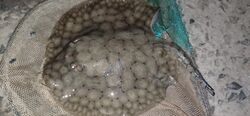Biology:Short-tailed river stingray
| Short-tailed river stingray | |
|---|---|

| |
| Juvenile | |
| Scientific classification | |
| Domain: | Eukaryota |
| Kingdom: | Animalia |
| Phylum: | Chordata |
| Class: | Chondrichthyes |
| Subclass: | Elasmobranchii |
| Superorder: | Batoidea |
| Order: | Myliobatiformes |
| Family: | Potamotrygonidae |
| Genus: | Potamotrygon |
| Species: | P. brachyura
|
| Binomial name | |
| Potamotrygon brachyura (Günther, 1880)
| |
The short-tailed river stingray (Potamotrygon brachyura) is a species of river stingray (family Potamotrygonidae) native to the Río de la Plata Basin in South America.[2][3] It is sometimes known as the giant freshwater stingray,[1] but this name is typically used for the southeast Asian Urogymnus polylepis.
Growing to a disc diameter of about 1.9 m (6.2 ft) and a weight of 220 kg (490 lb), with unconfirmed records of even larger specimens,[4] the short-tailed river stingray is the largest freshwater species in its family[3] and one of the heaviest strict freshwater fish in South America, only matched by the arapaima (Arapaima) and piraíba catfish (Brachyplatystoma filamentosum).[5] The primary threat to the short-tailed river stingray is fishing for food and as a game fish (if not released), but it is also under pressure from habitat loss and occasionally caught for aquaria.[1][5][6]
Description
The short-tailed river stingray is circular in shape and humped in the back.[7] The species can reach about 1.9 m (6 ft) in disc diameter and 220 kg (490 lb) in weight, making it the largest freshwater species in the family Potamotrygonidae.[3][4][8] They have a dark pattern on their backs, probably used as camouflage.[7] The ray's tail is very muscular and thick, covered with short spines at the base and a venomous sting at the end.[9]
Distribution
The short-tailed river stingray is found in the Río de la Plata Basin, including the Paraguay, Paraná and Uruguay Rivers in the countries of Argentina, Brazil, Paraguay and Uruguay.[1][2][3] It may also range into Bolivia in the Pilcomayo River (a tributary of the Paraguay River), but this remains unconfirmed.[5] In the north it ranges from the upper Paraguay River basin, including the Pantanal, and south to the lowermost freshwater sections of the Río de la Plata.[5] Unlike some other freshwater rays, it has not been able to spread to the upper Paraná River basin after the Itaipu Dam flooded the Guaíra Falls, which represented a natural barrier to its range.[5]
Lifestyle
Female short-tailed river stingrays give birth to up to 19 fully formed young stingrays per litter.[1][6] The pups start off eating plankton and then move on to consume small mollusks, crustaceans, the larvae of aquatic insects, and fish.[1][6]
References
- ↑ 1.0 1.1 1.2 1.3 1.4 1.5 Charvet-Almeida, P.; Soto, J.M.R.; Pinto de Almeida, M. (2009). "Potamotrygon brachyura". IUCN Red List of Threatened Species 2009: e.T161687A5480430. doi:10.2305/IUCN.UK.2009-2.RLTS.T161687A5480430.en. https://www.iucnredlist.org/species/161687/5480430. Retrieved 20 November 2021.
- ↑ 2.0 2.1 Froese, Rainer and Pauly, Daniel, eds. (2017). "Potamotrygon brachyura" in FishBase. January 2017 version.
- ↑ 3.0 3.1 3.2 3.3 Oddone, M.C., G. Velasco & G. Rincon (2008). Occurrence of freshwater stingrays (Chondrichthyes: Potamotrygonidae) in the Uruguay River and its tributaries, Uruguay, South America. International Journal of Ichthyology 14 (2): 69-76.
- ↑ 4.0 4.1 Fishing World Records: Potamotrygon brachyura. Retrieved 3 August 2023.
- ↑ 5.0 5.1 5.2 5.3 5.4 Lucifora; Barbini; Vegh et al. (2016). "Geographic distribution of the short-tailed river stingray (Potamotrygon brachyura): assessing habitat loss and fishing as threats to the world's largest obligate freshwater elasmobranch". Marine and Freshwater Research 67 (10): 1463–1478. doi:10.1071/MF15003. http://pdfs.semanticscholar.org/15ec/e4ccde0732d2b6e1ddf903400726da6ca087.pdf.
- ↑ 6.0 6.1 6.2 "Short-tailed river stingray". Discovery. http://animal.discovery.com/fish/river-monsters/short-tailed-river-stingray.html.
- ↑ 7.0 7.1 River Monsters, First Edition, Da Capo Press, 2011, p. 165
- ↑ Rays of the World. CSIRO. 2016. pp. 626 & 630. ISBN 9780643109148.
- ↑ River Monsters, First Edition, Da Capo Press, 2011, p. 162
External links
Wikidata ☰ Q1642212 entry
 |


